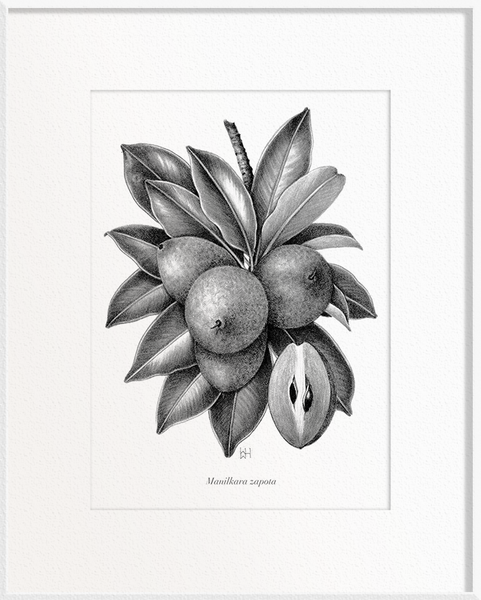Manilkara zapota (Chiku)
Manilkara zapota, commonly known as chiku, chikoo, sapodilla, sapota, naseberry or nispero, is within the family Sapotaceae. It is a long-lived, evergreen tree native to southern Mexico, Central America and the Caribbean. It was introduced to the Philippines during Spanish colonisation. It is grown in large quantities throughout Southeast and South Asia. Manilkara zapota is a small tree (grows up to about 10 metres) with light grey bark. The fruit is oval or round and the sweet flesh is pinkish white to reddish brown. The fruits are relished by bats who gorge on them. In Asia it is valued for the fruit, but in South America it is appreciated for its timber and latex. The gummy latex called 'chicle' is released when the fruit is picked and used as an ingredient in chewing gum. A compound from the leaves displays anti-diabetic, antioxidant and cholesterol-lowering properties.
°°°°°
Specifications:
Paper
100% Cotton based, 320g, Acid-free, No optical brighteners.
Printed Area
A4, 210mm x 297mm – Approximately 142mm x 210mm
A3, 297mm x 420mm – Approximately 230mm x 319mm
About the Collection
The Garden of Miss Joaquim Collection: Illustrated Botanical Prints
Agnes Joaquim was a Singapore-born Armenian who created what would become Singapore’s National Flower, the Vanda Miss Joaquim (scientific name: Papilionanthe Miss Joaquim), in 1893. The artificial hybrid was recognised by the first director of the Singapore Botanic Gardens, botanist Henry Ridley.
Agnes, the first woman in the world to create a hybrid orchid, was a well-known and successful horticulturist, garnering 70 horticultural awards from 1881 to 1899. The Garden of Miss Joaquim Collection of botanical prints commemorates her horticultural legacy and complements her story told in the book Agnes and Her Amazing Orchid.
In presenting Agnes’s award-winning plants in the illustrated collection, we looked at the newspaper records of the times, but they were of no use because they used common name descriptions of the plants, such as ‘rose’ and ‘durian’. So we turned to the Singapore Botanic Gardens and collaborated with a botanist to identify the likely species. To complete Agnes’s story, the collection includes two additional images: of Vanda Miss Joaquim’s parents, Papilionanthe teres (pod parent) and Papilionanthe hookeriana (pollen parent) — formerly in the genus Vanda — both of which may have been present in her award-winning floral bouquets or cut flowers. Waiwai Hove, a talented and respected botanical illustrator, was chosen to produce the prints.
*Disclaimer: Representative only based on subject. Not species definitive.
About the Illustrator
Born in Kuala Lumpur, Malaysia, Waiwai Hove developed a love for nature from a young age. Growing up surrounded by rich tropical flora and nurtured by her mother, a keen gardener, Waiwai has always held a special place for plants in her childhood memories. She holds a diploma in botanical illustration from the Society of Botanical Artists (UK), graduating in 2013 with a distinction and the highest marks in the history of the course.
She has since worked for the Singapore Botanic Gardens, where highlights include illustrations for ‘30 Heritage Trees’ and more recently ‘15 Gingers’. Four of Waiwai’s ginger paintings were subsequently used for a series of stamps issued by Singapore Post in 2018. Since 2019, Waiwai has begun working on the cover illustrations of 14 volumes of The Flora of Singapore, to be published over the next few years. Her works are in numerous private collections and can also be found in publications by the National Parks Board and in the Shirley Sherwood Collection in Kew Gardens, UK.




